
Research exploring human behaviour in tunnel disaster evacuation is limited for obvious logistical reasons, and the studies that do exist are generally retrospective in nature. Much of our understanding comes from analysis of building fire evacuation, or the use of computer modelling, which only partially accounts for human behaviour.
Prior to Wood (1972), human behaviour was not considered in evacuation research or planning. Tong and Canter (1985) undertook a literature review of motivational factors affecting evacuation during building fires to discredit the prevalent presumption of a ‘panic’ response in such situations. This was important as it had prevented a more detailed examination of people’s motivation in fire situations.
Sime (1995) argued that behaviour in fire situations can be predicted. People tend to use familiar escape routes, take guidance from staff, and move as part of family or known social groups. They felt pre-evacuation time or the ‘period of ambiguity’ is critical, as the social exchange of information, in addition to other sources, can expedite or inhibit decision-making and response.
Kobes et al. (2010) conducted a literature review on human behaviour in building fires and delineated how recent studies have shown several human behaviours in fire evacuation. Walking pace was slower in smoke or in an abnormal environment. Even normally-mobile people, in a fire situation, exhibited a degree of limitation, making them less self reliant. There was a high lack of awareness of ceiling signage, with 92 per cent of survivors in 400 cases of fire escape, being unaware of escape route signage. Luminescent low-level exit markings were found to be more effective. The preference for people to evacuate through familiar rather than closer, unfamiliar exits, especially if closed or alarmed, was reiterated in this review. The chosen route was also affected by affiliate behaviour. Desire to conform to the family or friend group strongly influenced occupants’ inertia to danger signals when failing to initiate evacuation.
Human behaviour in the first moments of an incident in a tunnel is crucial in an evacuation. An analysis of three fatal tunnel fires in Europe by Voeltzel and Dix (2004) reported an average 15 minute fire brigade response time. The study detailed that drivers, ignoring a red signal and siren, proceeded to ‘queue’ within danger zones resulting in fire spreading between cars. This failure to evacuate resulted in mortality.
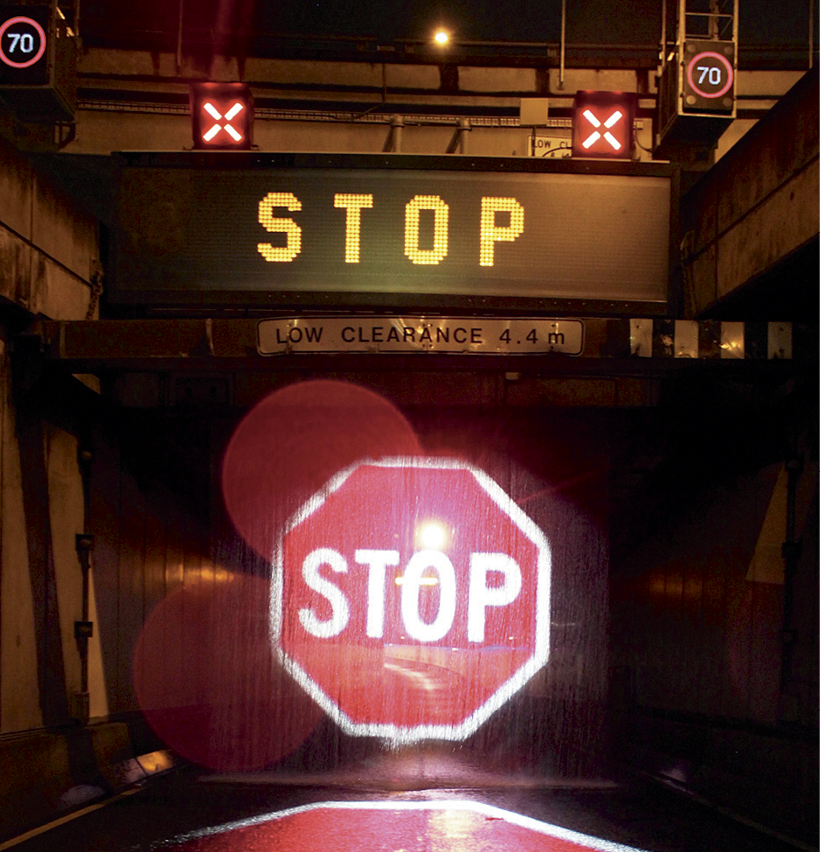
Image: Kate Sandy
Stop sign at entrance to the Sydney Harbour Tunnel southbound carriageway. It was developed to stop motorists entering the tunnel after other warning signs had failed to achieve this. It consists of a cascading wall of water on which a stop sign is projected.
Findings from a series of field studies by Boer (2002) suggest tunnel users may frequently over-estimate their response capacities in an emergency. The author reported substantial differences between what people thought they would do in a tunnel evacuation situation and the observed behaviours in exercises. Participants were generally unprepared, with group affiliation (‘clustering’) appearing to inhibit individual decision-making and response.
Recent studies have also focused on how people perceive warning information and its relationship to evacuation decision-making, showing substantial variability in the capacity to register particular warning cues. Multiple sources are typically used with social information exchange (observing others, ‘checking’) being a common mediator of response decisions including the decision to vacate vehicles and the choice of exit (Nilsson, et al., 2009).
Users of rapid transit train systems in Singapore showed low response to fire alarm warnings which they reported to be ambiguous; however they did prompt more than half to observe the reactions of others or approach staff. A live announcement was found to clarify the initial cue and resulted in 85 per cent of people believing they should leave immediately. This highlights the need for ‘live’ information from an authority (Yeo and He, 2009).
The Sydney Harbour Tunnel (SHT) is a crucial infrastructure linking the northern and central Sydney business districts across Sydney Harbour. There are two northbound lanes and two southbound lanes for cars, each bordered by 0.85 metre high concrete jersey barriers and connected by pedestrian cross tunnels (ranging from 22 metres in the northern land tunnels to just a fireproof door in the immersed, undersea, tunnels) for use in evacuations. The concrete jersey barriers must be climbed to access the cross tunnels to exit.
Although the comprehensive emergency warning and evacuation systems within the SHT receive regular functional testing, there has never been a requirement to use these procedures during a ‘live’ event with trapped vehicles. This study aimed to determine key aspects of response during a simulated emergency evacuation, specifically:
Thirty two volunteers aged between 16 and 81 years participated in the evacuation scenario. They were not told what to expect, only that they should behave in the way they thought they would in any real event to keep themselves safe. Participants travelled in existing social/family groups of one to four people per car. Several individuals were allocated to vehicles with fewer occupants.
The set-up of the test was, for safety reasons, inherently a ’low threat‘ scenario with occupants remote from the fire and smoke. This may have impacted on human behaviour during the event but was not avoidable.
Evaluation of the behavioural response within the exercise consisted of:
The burn was monitored by over 20 fire brigade personnel including an incident commander and several fire trucks. The ’burning car‘ was located in the northbound carriageway 240 metres from the north exit. The participants’ vehicles made a 40km per hour approach from the south behind a lead car and stopped about 100 metres before the burning car.
Within 55 seconds after all the cars had initially stopped, an announcement was relayed in two forms—over the radio, which was only heard by those with their car radios switched on, and over the public announcement system (PA) of the tunnel, which was heard most clearly by those with car windows down.
.png)
Image: Kate Sandy
Car fire being extinguished by emergency crew.
Figure 1. The three evacuation recording transcripts for the Sydney Harbour Tunnel.

There was an initial period of inertia of less than a minute during which no participants left their cars before the first audio announcement asked people to remain in their cars and await instructions. It is impossible to know how much longer participants would have delayed before initiating evacuation without any audio instructions. In that first minute much indecision was shown by participants with some starting to exit cars, then retreating and closing doors, heads protruding from windows and photos being taken out of windows. Once the audio messaging commenced, those who could hear it followed instructions. Those who couldn’t hear it tended to follow others. The subsequent evacuation to the cross tunnel was completed in less than two minutes. The audio instructions clearly influenced people to evacuate. Participants then walked to the non-incident southbound carriageway where they were guided north the final 540 metres to the SHT offices.
Table 1: Evacuation timeline. Time zero taken from the moment all vehicles had come to an initial stop.
Response phase |
Mins: secs |
Events |
|---|---|---|
Initial inertia phase |
0:00 |
All cars come to an initial stop behind the lead vehicle ~100 metres from the burning cars. Ceiling signs are visible: “turn off engine” and “turn on radio.” |
0:16 |
First movement from participants outside car: several heads protruding from open car window. |
|
0:53 - 0:57 |
First car door opens, then closes when tones of first PA message start. |
|
Audio instructions to wait in car followed |
0:55 – 1:15 |
PA speaker starts first announcement asking people to stay in their cars and await further instruction (Figure 1 paragraph 1). |
1:25 |
The last car finally stops manoeuvring. |
|
Evacuation phase |
2:12 |
Announcement says ”you are now required to evacuate the tunnel.” |
2:12 |
First person, young male, exits car and is followed steadily by all other participants. There is no sense of urgency. |
|
4:04 |
All participants have left the incident tunnel. |
|
Safety reached 2 mins 5 secs |
4:19 |
Last person exits the cross tunnel into the non incident southbound tunnel. |
Evacuation continues in non-incident tunnel |
In southbound tunnel evacuees follow audio instructions. |
The main warning systems in the tunnel are:
When asked “What was the very first thing you noticed to indicate there was a problem?”, various indicators were mentioned (see Figure 2). Most smelt or saw smoke or noticed the cars in front were slowing or stopping. The authors found no data on how the distance from a tunnel fire impacted on human response but felt these responses would be affected by a participant’s proximity to the event and this would reflect what would occur in a real event.
Figure 2. Participant responses to “What was the very first thing you noticed to indicate there was a problem?”
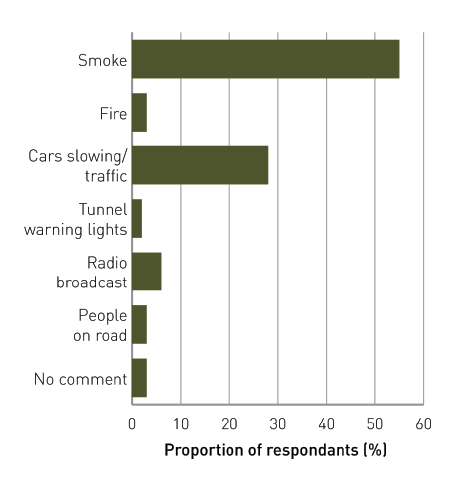
The first visual alert for all participants was smoke or fire. The majority of these saw smoke (84 per cent). When asked what the first audio cues were, 85 per cent nominated the emergency announcement via the radio (41 per cent), the PA (38 per cent), or simultaneously (6 per cent). Several heard human voices or a rumble first.
During an incident in the SHT, the same announcement is played simultaneously on the car radio and the tunnel PA. If a CD is playing in the car, or if the radio is tuned to a station not broadcasting the message, then the radio announcement may not be heard. Participants commented that it was hard to hear the tunnel PA announcement through closed windows.
When asked “How did you know what to do?”, three quarters of participants said they made decisions based on audio messaging, 13 per cent based decisions on overhead signs, and others did not know what to do, they “just followed”.
In knowing when to initiate evacuation the vast majority of respondents (75 per cent) relied on audio messages and it was clear from video observations that the first evacuees began evacuating within seconds of hearing the instructions to “evacuate the tunnel”. Only 13 per cent decided to evacuate based on signage, while 12 per cent of the participants did not use audio or visual signage cues to initiate evacuation.
Figure 3. Participant responses to “If you decided to evacuate when did you make this decision and why?”
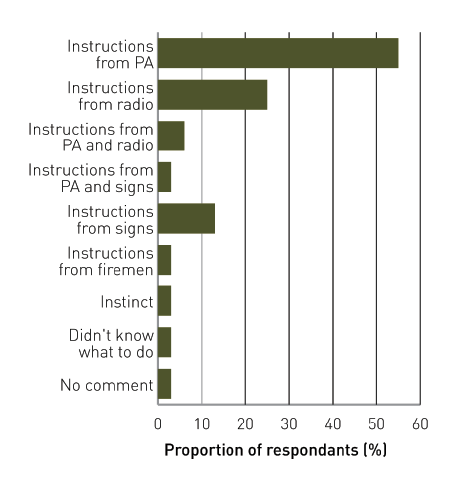
Greater than one third commented on the difficulty in hearing the audio cues. Responses included, “I tended to follow the pack when I could no longer hear the PA”, “there was no radio announcement in our vehicle”, “the PA is not clear if windows are up and the radio is on”. Some participants were unable to distinguish the audio cues at all and had to rely on following others.
The authors feel that ‘inertia to evacuate’ is a barrier to safe behaviour in tunnel incidents and understanding what factors help people to make the decision to leave the dangerous area is important for planning. In this exercise audio messaging was crucial in initiating the evacuation of the group. Of concern were the participants who couldn’t hear the audio message. In some cases they had a CD playing or were tuned to a radio station which did not relay the message. Others relied on the PA but had problems hearing and/or understanding the message, for instance due to external noise.
Observations from film taken at the time clearly showed the role of social influence with 94 per cent of participants reporting their decision-making was influenced by the action of others. The first to exit their car was a group of young males. Others then followed. Participants appeared reluctant to initiate leaving their car. One person commented “[I] opened the door when I saw the sign above then saw others still in cars so got back in and shut the door”. Another mentioned “when other people hesitated to leave their vehicles, it made us unsure”. Others wound down windows to see what others were doing and reported “as soon as one person opened the car door so did we”.
Reasons given for following others included:
Comments included “lemming for sure”, “I assumed everyone knew what to do”, “I believed they had seen something I didn’t”, “it was reassuring that others were doing the same so I kept going”.
The participants considered the major impediment to evacuation was physical; in particular, the Jersey barriers which had to be climbed to access the cross tunnel. One fifth noted the convergence of evacuees at the entrance to the cross tunnel which was confirmed by video footage. This was compounded as participants mounted the barriers at the same point as the cross tunnel exit door. Other impediments included curiosity (9 per cent), physical limitations - self or other (19 per cent), others’ inaction, a delay before the PA message to evacuate, the poor clarity of the PA messaging, and reluctance to follow instructions to leave the keys in the car. Only 16 per cent felt totally unimpeded during the evacuation.
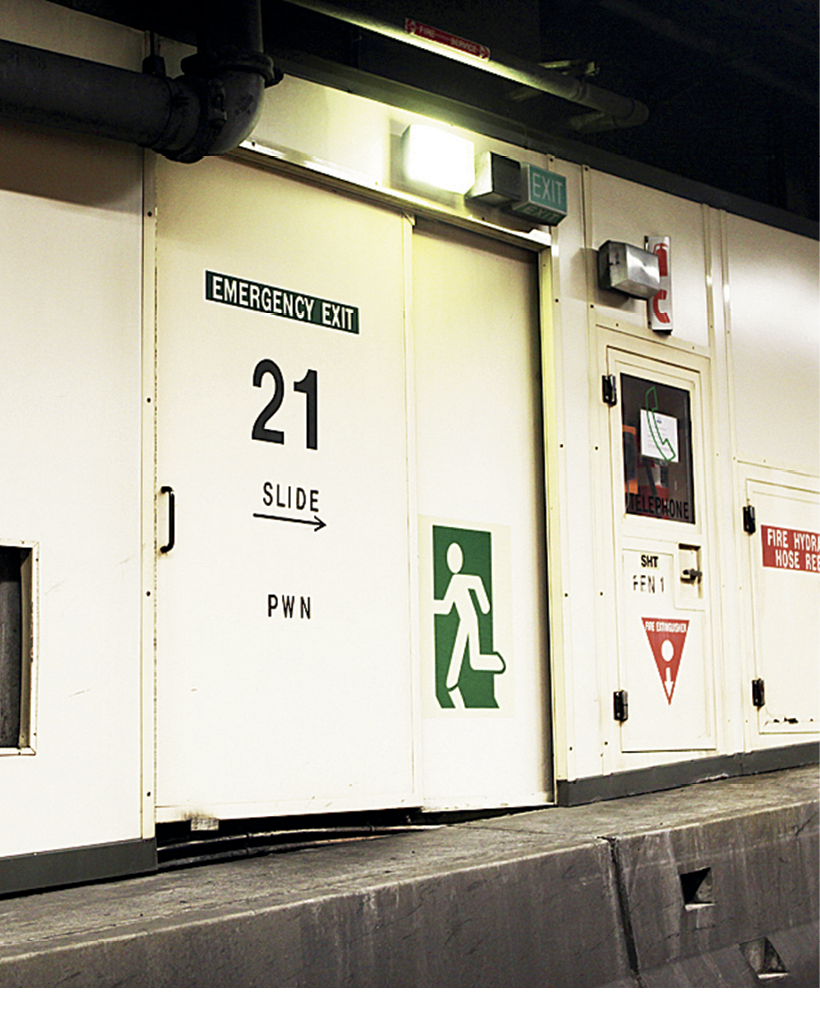
Impediments to evacuation. The jersey barriers had two small cut away steps (visible in bottom right of this photo) which the elderly participants were unable to use without assistance. They took around five seconds to climb the barriers with assistance.
Fire incidents in tunnel environments are high-risk events compared to fires in more open environments. This is due to greater smoke volumes at an early stage of the fire (due to containment of smoke at the beginning of the fire before ventilation commences), greater distance of fire spread between vehicles (due to radiation containment and reflection), hotter fire temperatures of greater than 1000oC, and the unknown behaviour of road tunnel users in these situations (Dix, 2010). There has only been one recent tunnel fire in Australia which occurred in the Burnley Tunnel, Melbourne, Victoria, in 2007. Three people died and several hundred were evacuated. However the number of road tunnels and the volume of traffic using major road tunnels in Australia is increasing. There are now five tunnels in NSW, three in Victoria, and two in both Queensland and Western Australia with high vehicle numbers over 1km long.
In this exercise the SHT controllers activated and ran the emergency procedures efficiently and smoothly. These procedures are exercised, albeit without live subjects, on a six-monthly basis. It is likely that this level of preparedness and the existing infrastructure to support evacuation contributed to the rapid response during this exercise.
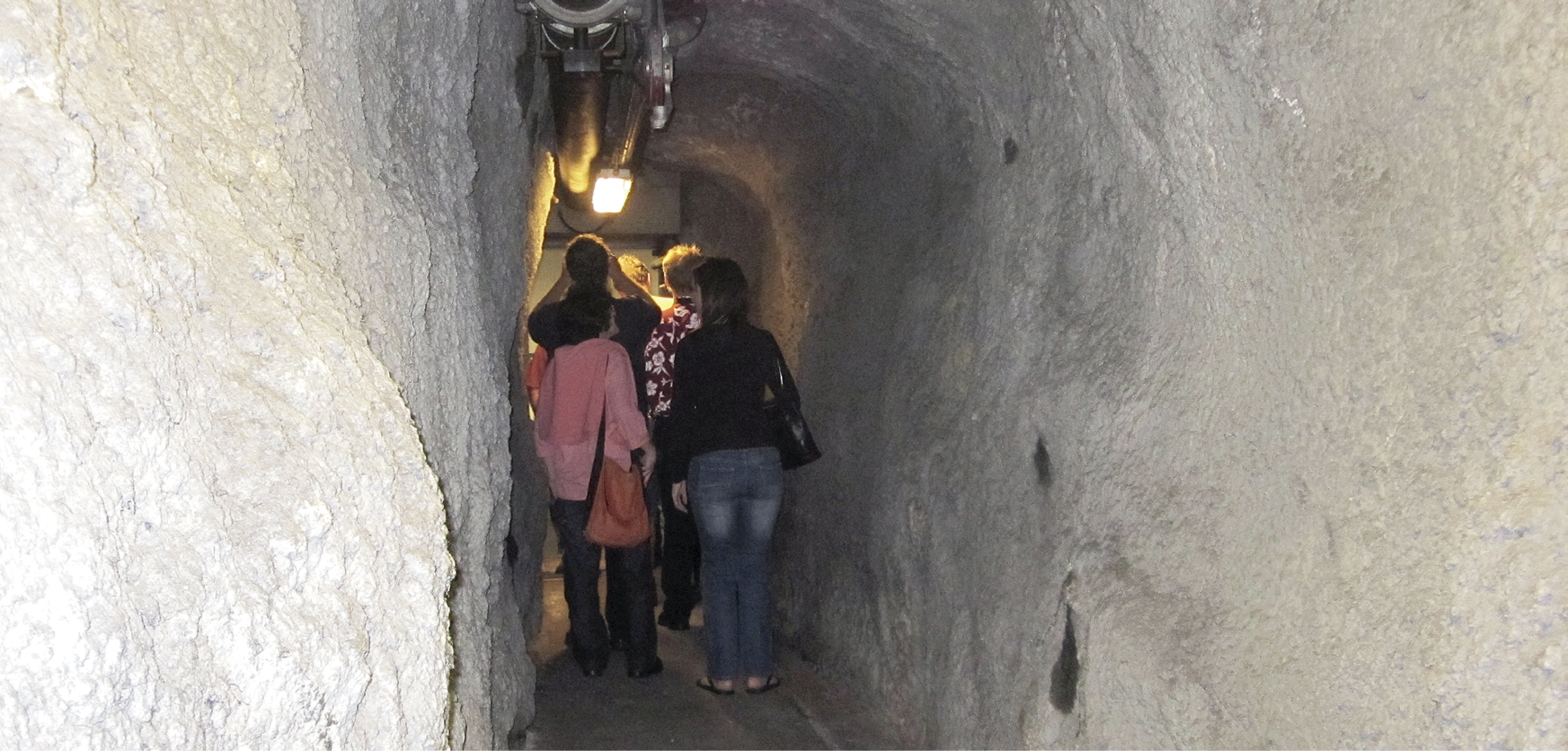
Image: Kate Sandy
Exit cross tunnel, part of the evacuation route.
The difficulty in running a ’realistic’ scenario was demonstrated by comments from some participants. Several volunteered that in a real situation they would have approached the burning car to check for occupants, or out of curiosity. Participant response times may also have been affected. Nevertheless important data can still be gathered from these more restricted evacuation exercises.
Human behaviour in building evacuation is conceptually similar to that of tunnel evacuation once the tunnel users have chosen to leave their vehicles. There are external factors which are somewhat different in tunnels, as in this case, where there was a delayed evacuation response until clear direction was received. Prior to the audio announcement there was a lot of indecision by participants shown on film footage and expressed by participants in the questionnaire. Cars were still manoeuvring one and a quarter minutes after they had originally come to a stop and people were starting to exit vehicles, then changing their minds, getting back in and closing doors.
Current international data highlights audio messaging as one of the most effective sources of warning (Kobes, et al., 2010). This was confirmed in the present study where visual signs were poorly registered by the majority of participants and audio signals clearly prompted the first participants to evacuate.
As shown in international evidence ‘live’ messages may also be attended and responded to more quickly and, if possible, these could augment or replace the current recorded message. Audio warnings that are early, clear and loud, provide simple instructions and, as such, may reduce the duration of ‘evacuation inertia’. A recent study in the SHT showed high background noise and long reverberation degrade of the transmission of warning systems. This is an issue for clear transmission of PA systems (Ridley and Spearitt, 2011). In-car messages will not be received by some, highlighting the need for a clear, loud PA as a secondary (and out-of-car) source.
On several occasions informational social influence over-rode audio messaging. There were a number of reported examples of people assuming the actions of others to be the correct behaviour based on perceived greater knowledge of the situation. This social phenomenon is known as ‘informational social influence’, and may be exaggerated in hazard situations (Dynes, 2006, Nilsson, et al., 2009). Film footage clearly showed a delay in the initiation of evacuation in this exercise with several people opening car doors to exit, then closing them on realising no one else was doing the same thing.
Unlike two of the previous tunnel exercises in the Netherlands and Sweden (Nilsson, et al., 2009, Boer, 2002) participants in the SHT exercise chose their exit point based on which cross tunnel others were using, rather than by proximity or distance from danger. Initiation of evacuation, and choice of exit route, was highly influenced by what other people were doing during this exercise. There was orderly follow-the-leader behaviour of one large group with occasional individual behaviour which quickly conformed back to the group. There was a general lack of urgency shown by the group although several individuals later expressed feeling anxious in the questionnaire (highlighting the importance of obtaining data through different methods).
Such a response may be influenced by the relative safety of being in an exercise situation. However it raises the important point that individuals in actual hazard situations often opt for the ‘safety’ of being with others, displaying affiliate behaviour, even if this is at the cost of being closer to the threat (Sime, 1995).
The group seemed to move as a single herd, rather than as a collection of smaller groups but no participant took leadership of, or responsibility for, the group as a whole. This is consistent with stories of evacuation through the stairwells after the terrorist attacks of 9/11 of a slow orderly procession without panic (Hingson and Flory, 2011).
In such situations vehicles are a familiar entity in an unfamiliar environment containing valuable personal property. It was demonstrated by several participant drivers in this exercise whose concerns included:
Importantly, such vehicle affiliation has also been observed in tunnel emergencies where the presumed greater safety of being in, or near, one’s vehicle has contributed to fatalities through people failing to evacuate dangerous environments (Masellis, et al., 1997). In some emergencies remaining in the car is required. In others, it is safer to evacuate the vehicle.
This study also demonstrated the need for better design consideration for the less physically able as they slowed the evacuation of the rest of the group and were unable to evacuate themselves without assistance.
This exercise was an opportunity to observe the main constraints and facilitators to rapid evacuation of people in a potentially dangerous situation. The current under-emphasis on user psychological and behaviour patterns in tunnel evacuations is changing. The lack of familiarity of the environment, the negative perception of tunnels, and the greater risk from fire constrained by tunnels may increase the complexity of planning tunnel evacuations. When there is increased duress, decision-making can be constrained and clear audible instructions are important.
Evidence-informed guidelines for evacuation best-practice and subsequent follow-up of persons involved in tunnel evacuations, including road users and response personnel, would help ensure lessons are learned and incorporated into future response practice.
Penelope Burns is a GP Fellow of Disaster Medicine with the Disaster Response and Resilience Research Group in the School of Medicine at the University of Western Sydney and a general practitioner in Rozelle, Sydney. Email: P.Burns@uws.edu.au
Garry Stevens is a Clinical Psychologist and Research Fellow at the Disaster Response & Resilience Research Group, School of Medicine, University of Western Sydney.
Kate Sandy is a medical student at the University of Western Sydney. She has a Diploma in Film and a Certificate in Screenwriting from the Australian Film Television and Radio School.
Bob Allen is the General Manager of the Sydney Harbour Tunnel Company with which he has been involved for 20 years. He has a background in operations management gained predominantly in submarines through the Royal Navy and the Royal Australian Navy.
Arnold Dix is a scientist and a lawyer who is an international expert on tunnel risk matters. He is an Associate Professor at the University of Western Sydney. He has audited tunnels for safety and has investigated many recent international tunnel incidents.
Professor Beverley Raphael is Professor of Population Mental Health and Disasters and Director of the Disaster Response and Resilience Research Group at the University of Western Sydney. She is also Professor of Psychological and Addiction Medicine at the Australian National University.
Anon., 2010. Mob Mentality. Science Illustrated, Jan-Feb, Issue 3, pp. 52-59.
Arias, A.V., Mayordomo Lopez, S., Fernandez, I., Martinez-Rubio, J. L., Magallares A., 2008. Psychosocial factors, perceived risk and driving in a hostile environment: driving through tunnels. International Journal of Global Environmental Issues, 8(1 & 2), pp. 165-181.
Beard, A., 2009. Fire safety in tunnels. Fire Safety Journal, Volume 44, pp. 276-278.
Boer, L., 2002. Behaviour by motorists on evacuation of a tunnel, Soesterberg: The Ministry of Transport, Public Works and Water Management, Centre for Tunnel Safety.
Brennan, P., 1997. Selected Literature Reviews on Human Behaviour in Fire, Sydney: Fire Code Reform Centre Limited.
Callaghan, P., 2010. Tunnel Exercise furthers safety research. Emergency, December, p. 24.
Colombo, A., 2001. NEDIES PROJECT Lessons Learnt from Tunnel Accidents, s.l.: Institute for Systems, Informatics and Safety .
Dix, A., 2010. Tunnel Fire Safety in Australasia. Frankfurt am Main, Germany, s.n., pp. 69-79.
Dynes, R., 2006. Social Capital: Dealing with Community Emergencies. Homeland Security Affairs 2, July. Issue 2.
Fahy, R. and Proulx, G., 2001. Towards creating a database on delay times to start evacuation and walking speeds for use in evacuation modeling. Human behavior in fire-understanding human behavior for better fire safety design. London, s.n., pp. 175-183.
Fraser-Mitchell, J. and Charters, D., 2005. Human Behaviour in Tunnel Fire Incidents. Fire Safety Science, Volume 8, pp. 543-554.
Hingson, M. and Flory, S., 2011. Thunderdog. Nashville : Thomas Nelson Inc.
Kobes, M., Helsoot, I., de Vries, B. and Post, J., 2010. Building safety and human behaviour in fire: A literature review. Fire Safety Journal, pp. 1-11.
Landrigan, PJ., Forman, J., Galvez, M., Newman, B., Engel, S.M., Chemtob, C., 2008. Impact of September 11 World Trade Center Disaster on Children and Pregnant Women. Mount Sinai Journal of Medicine, Volume 75, pp. 129-134.
Masellis M., laia A., Sferrazza G., Pirillo E., D’Arpa N., Cucchiara P., Sucameli M., Napoli B., Alessandro G., Giairni S., 1997. Fire Disaster in a Motorway Tunnel. Annals of Burns and Fire Disasters, 10(4).
Meredith, P., 1992. The Sydney Harbour Tunnel Foldout Map. Australian Geographic, Jul-Sep, Issue 27.
Meyer, H., 2003. The Kaprun cable car fire disaster - aspects of forensic organisation following a mass fatality with 155 victims. Fensic Science International, pp. 1-7.
Nilsson, D., Johansson, M. and Rantzich, H., 2009. Evacuation experiment in a road tunnel: A study of human behaviour and technical installations. Fire Safety Journal, pp. 458-468.
Norris, F., 2005. Range, Magnitude, and Duration of the Effects of Disasters on Mental Health: Review Update 2005. Review Update 2005.
Norris, F., Friedman, M. and Watson, P., 2002. 60,000 Disaster VIctims Speak: Part II. Summary and Implications of Disaster Mental Health Research. Psychiatry, 65(3).
Norris, F., Friedman, M., Watson, P., Byrne, C., Diax, E., and Kaniasty, K., 2002. 60,000 Disaster Victims Speak: Part I. An Empirical review of the Empirical Literature, 1981-2001. Pyschiatry, 65(3).
Peleg, T. and Shalev, A., 2006. Longitudinal Studies of PTSD: Overview of Findings and Methods. CNS Spectrums The International Journal of Neuropsychiatric Medicine, 11(8), pp. 589-602.
Ridley, P. and Spearitt, D., 2011. Evaluation of speech transmission in a road tunnel. Acoustics, pp. 1-8.
Sime, J., 1991. Accidents and disasters: vulnerability in the built environment. Safety Science, pp. 109-124.
Sime, J., 1995. Crowd psychology and engineering. Safety Science, Volume 21, pp. 1-14.
SWOV Institute for Road Safety Research, 2009. SWOV Fact sheet: The road safety of motorway tunnels, Leidschendam: SWOV.
Tong, D. and Canter, D., 1985. The Decision to Evacuate: a Study of the Motivations which Contribute to Evacuation in the Event of Fire. Fire safety Journal, Volume 9, pp. 257-265.
Voeltzel, A. and Dix, A., 2004. A Comparative Analysis of the Mount Blanc, Tauern and Gotthard Tunnel Fires. Routes Roads, Volume 324, pp. 18-34.
Weiger, P., 2000. Road tunnel fire safety. NFPA Journal,
Jul/Aug.
Wood, P., 1972. The Behaviour of People in Fires. Fire Research, Volume Note No. 953.
Yeo, S. and He, Y., 2009. Commuter characteristics in mass rapid transit stations in Singapore. Fire Safety Journal, pp. 183-191.